

  |
|
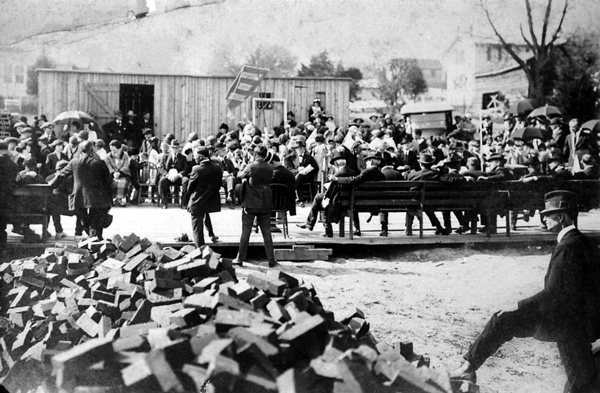
|
Name: Laying the Cornerstone for Scottsville School Date: May 5, 1924 Image Number: Roll5Neg24A Comments: In 1924, Masonic Lodge #45 laid the cornerstone for Scottsville's new school on West Main Street. Pictured with his foot on the brick pile in the left forefront of above photo is Arthur Thacker, father of Scottsville's Mayor Raymon Thacker. Shown below at the bottom of the page is another scene from the cornerstone laying ceremony, which many Scottsville citizens attended. 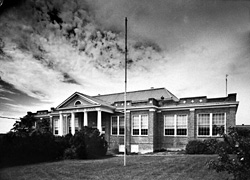 When completed in 1925 as shown at left, Scottsville School housed all grades from third
through high school until 1967 when it became a junior high and elementary school combined.
In 1968, Scottsville high school students began attending Albemarle High in Charlottesville.
The Leslie Walton Middle School, located halfway between Scottsville and Charlottesville,
opened in 1974. The new Scottsville Elementary School, just north of town on Route 20,
opened in the fall of 1979 for grades K-5.
When completed in 1925 as shown at left, Scottsville School housed all grades from third
through high school until 1967 when it became a junior high and elementary school combined.
In 1968, Scottsville high school students began attending Albemarle High in Charlottesville.
The Leslie Walton Middle School, located halfway between Scottsville and Charlottesville,
opened in 1974. The new Scottsville Elementary School, just north of town on Route 20,
opened in the fall of 1979 for grades K-5.To learn more about Scottsville High School, please read Ruth Klippstein's article below entitled "Dear Old Scottsville High", which was published in the Scottsville Monthly on January 11, 2013: Dear Old Scottsville High By Ruth Klippstein "Dear old Scottsville! Blessed the day, When we knew thy helpful sway, Learned to follow wisdom's footsteps for our guide. Filled with study, play and song, Hours which now we would prolong, Scottsville,Scottsville, Scottsville! Happy days with thee." This is one of the verses of the Scottsville School song, written by Principal William Day Smith (his tenure was 1907 to 1937) and remembered still. It conjures some of the strength of feeling, the devotion and memories, of students who attended the school. Scottsville has had several schools and a long history of education. The first high school in Virginia to be accredited by the state was Scottsville's in 1913. School was held in the brick Brady building, on the southeast corner of Valley and Main streets, from 1876 to 1906. It was superseded by the large frame school on the hill above Jackson Street, originally without running water but with the particularly memorable teacher Miss Willie Hickok, Wild Bill's cousin. In 1924 the Masons laid the cornerstone for Scottsville's last high school, at the end of West Main Street. At the time, Scottsville's population was growing, and the town had two large flour mills, an ice plant, braid factory, theater, two hotels, and two drugstores, a boarding house, and several restaurants. The new school was progressive, with the first school library in the state and a large auditorium with classrooms ranged around it, Bill Mason recalls. Physical education and domestic science were on the curriculum; there was an honor system. It must be remembered that the school was exclusively for white students and teachers. The youngest students, Grades One and Two, attended classes in the now-vanished building where the Scottsville Library stands. In Third Grade, they would go to the high school building -- "a move up, I guess," says Larry Stallings, though their class was held in the basement, across from the furnace room. "It was nice and warm." 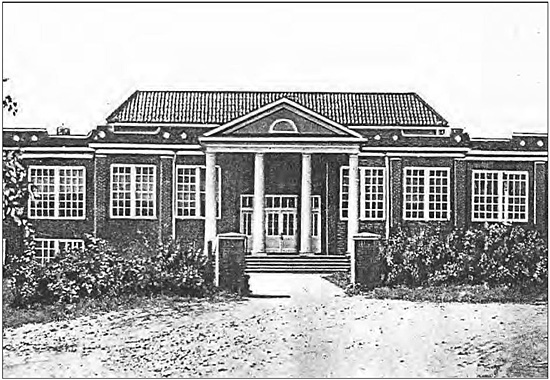 Scottsville High School in an undated post card view. For years high school was composed of grades eight through eleven; twelfth grade was added later. But when school opened in the autumn of 1968, Albemarle County moved the high school students into Albemarle High School, leaving Scottsville as a junior high and elementary school. An undated 1967 "Daily Progress" photograph shows valedictorian Mary Curtis and salutatorian Keith Rittenhouse looking "sadly at the building that holds many pleasant memories." Reunions have helped keep the memories alive and recement the bonds; at the 1988 reunion there was a representative from the class of 1919, Ruby Omohundro. 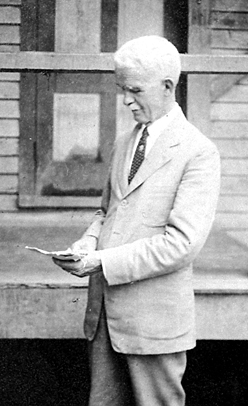 The yearbooks and literary magazines survive. "Ripples," started in 1932, offered sports
news, theatrical schedules, a meditation by Principal William Day Smith (shown at left), and gossip. May 6: "The other
day the school was hit by a miniature cyclone. This was no other than Jacqueline Beal who had lost precious notes. Not
only that, but someone had found them. Jacqueline wouldn't reveal what was in the notes, but we imagined, asked her and
received no answer --. Well, silence gives consent." And further on, "The Junior Class was rather bad on
Wednesday 13. The assignments Mr. Noble Smith had made were not done, consequently, the lid blew off and the class was
confronted with more lectures than they ever had in their gay, young lives, and now the Juniors have reformed."
The yearbooks and literary magazines survive. "Ripples," started in 1932, offered sports
news, theatrical schedules, a meditation by Principal William Day Smith (shown at left), and gossip. May 6: "The other
day the school was hit by a miniature cyclone. This was no other than Jacqueline Beal who had lost precious notes. Not
only that, but someone had found them. Jacqueline wouldn't reveal what was in the notes, but we imagined, asked her and
received no answer --. Well, silence gives consent." And further on, "The Junior Class was rather bad on
Wednesday 13. The assignments Mr. Noble Smith had made were not done, consequently, the lid blew off and the class was
confronted with more lectures than they ever had in their gay, young lives, and now the Juniors have reformed."The Scotty, the high school yearbook, has pictures in 1956 of students in a variety of clubs: international relations, commercial, public speaking, safety patrol, library. There was a band and a flute choir; basketball for both boys and girls; student council; and Future Farmers of America. Classes for vocational agriculture students, taught by Tom Allison, later the school's principal, were in the small block building near Bird Street and the current Scottsville Library. School life was full and rich, an important element of the town. Chub Walsh recalls the dirt basketball court and how the older boys would sit outside, "smoking our cigarettes and watching the girls go by." Students could leave school grounds for their noon meal; "town would be loaded with kids at lunchtime," getting a hot dog and soda at the restaurants or service stations. Some students, he says, would do the family grocery shopping, if their parents didn't have a car, and take bags home on the school bus. Chub says there was chapel in the auditorium every Wednesday, with preachers rotating from various churches in town. First graders sat in the first row, second in the second row, and so on sequentially through the eleventh graders. Older students also had study hall in the auditorium, though he doesn't remember a lot of studying going on. In Chub's day, Leslie Walton was principal. "Shorty" people called him - "but not to his face. He used to paddle you if you didn't behave yourself." Larry Stallings, who admits to never having been paddled, can describe the oak stump on legs, with the annual rings dated -- it was more than 100 years old-over which Walton "would fold you and paddle you." The stump is in the Museum, and other physical discipline, like slapping -- which Larry did endure -- is also gone. "The really nice thing about it was it was small and you knew everyone," Baxter Pitts says. "Teachers knew the families, your siblings; you weren't anonymous and couldn't get away with anything -- it kept us out of trouble. It was a good place to go to school," she recalls, and notes that she was well-prepared when she entered college, having had Hamner Goodwin for the last three years of English: "we all learned." Language electives were French and Latin; there was math up through Algebra II; general science, physics, chemistry, biology; shorthand and typing, home economics and shop, the voc ag, which her father taught. For physical education, all the grades, eighth or ninth through twelfth, were together -- Seniors chose squads, which then stayed together as the games rotated through softball, volleyball, and basketball, a week at a time. P.E. was offered just before lunch. Other, non-school activities are remembered too. Bill Mason says he usually wore a six inch hunting knife in a scabbard to school, or brought an ice pick stuck into a cork, for mumbledy peg, and "no one said anything about it. One boy was known as a knife trader; he could hardly keep his pants up he had so many pocket knives." Mumbledy peg competition got more and more complex and difficult as the game progressed. Larry Stallings recalls touch football, and four or five of his friends going down to the little creek at the south end of the grounds to play. They'd beat down the six-foot tall weeds with sticks-again, no one said anything about the sticks -- to make a clubhouse or tunnels. "That was nice." Games and sports were always important at Scottsville High School. Principal Smith originated Rally Day for all county schools; it "attracted statewide attention," according to the "Bicentennial History of Public Education in Albemarle County"; Scottsville won the first year and often afterwards. Bill Mason recalls the various relay races, with flags or blocks that had to be stacked, and especially his favorite game, dodge ball. Rally Day was at Lambeth Field, part of the University of Virginia along Emmet Street. 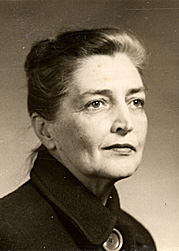 Everyone recalls good teachers at Scottsville School. Two special stories feature, from
Larry Stallings, Katherine Phillips (shown at left), the "loveliest woman and one of the best teachers I've ever had. She was a wonderfully nice woman, a humanitarian, not a disciplinarian,"
who introduced him in sixth grade to Steinbeck's "Of Mice and Men." He also tells of
Leslie Walton, "quite severe," "coming regularly into his fourth grade, taught by Miss Boggs, from West Virginia, to read Uncle Remus
stories." He read very well, but what the students didn't know was that this was the beginning of his courtship of Miss Boggs,
whom he eventually married. Larry left high school to support his family when his father became ill. He worked at the rubber
plant, went into the Navy during the war, and returned to Scottsville to finish high school - in the same class as his third
youngest sister in 1949.
Everyone recalls good teachers at Scottsville School. Two special stories feature, from
Larry Stallings, Katherine Phillips (shown at left), the "loveliest woman and one of the best teachers I've ever had. She was a wonderfully nice woman, a humanitarian, not a disciplinarian,"
who introduced him in sixth grade to Steinbeck's "Of Mice and Men." He also tells of
Leslie Walton, "quite severe," "coming regularly into his fourth grade, taught by Miss Boggs, from West Virginia, to read Uncle Remus
stories." He read very well, but what the students didn't know was that this was the beginning of his courtship of Miss Boggs,
whom he eventually married. Larry left high school to support his family when his father became ill. He worked at the rubber
plant, went into the Navy during the war, and returned to Scottsville to finish high school - in the same class as his third
youngest sister in 1949.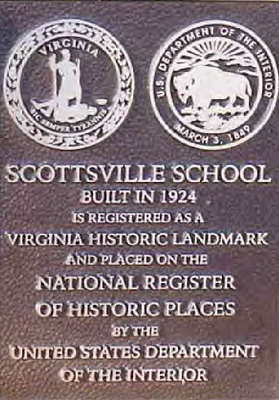 Many possibilities and promises left Scottsville with the closing of the school, but the venerable building, now on the National
Register of Historic Places, has had a rebirth. In 1991 the Jordan Development Corporation bought it and converted the
classrooms into 34 apartments for the elderly and disabled. In 2011 Piedmont Housing Alliance took over the project and began
planning substantial, expensive, renovation. Work on both exterior and interior began this past January; the apartments
were re-dedicated with an open house in November 2012.
Many possibilities and promises left Scottsville with the closing of the school, but the venerable building, now on the National
Register of Historic Places, has had a rebirth. In 1991 the Jordan Development Corporation bought it and converted the
classrooms into 34 apartments for the elderly and disabled. In 2011 Piedmont Housing Alliance took over the project and began
planning substantial, expensive, renovation. Work on both exterior and interior began this past January; the apartments
were re-dedicated with an open house in November 2012. Remarks by representatives of the many groups and banks responsible for developing and funding the project indicate the broad support for it and the sense of celebrating a job well done. "What a great occasion," said Forrest Kerns, president of Jordan. Stuart Armstrong spoke for the Piedmont Housing Alliance; he recognized Martin Horn, Inc, who did the construction. Renovations brought the building back to its original external look and added state-of-the-art heating and air conditioning to the rooms. Harold Trent of the Virginia Community Development Corporation congratulated everyone concerned; "I am quite impressed," he said. "It is impeccable work, and looks great." The careful renovation earned historic tax credits from both state and federal governments; the building will have to maintain compliance for 15 years to retain the credits. Rick Funk, vice president of dBF assoc., the architects, found the experience of bringing high-quality rental units to seniors so they can stay in Scottsville "a most rewarding aspect of the project." Jeffrey Plank, chair of the Scottsville's Architectural Review Board, said in his address, "What a splendid job, what attention to detail, what care, and what restraint." He noted the importance of the structure in the downtown Historic District, and that "its restoration insures that an iconic public building and the function of its first life, that of an every-grade public school, will remain part of the town's landscape." "In this building," he concluded, "we see the continuity of our built environment - a 1925 building picking up on the features of our 1825 buildings, and this 2012 renovation giving it new life in the 21st century, a building full of life and memories for all ages, and now for all of our people." 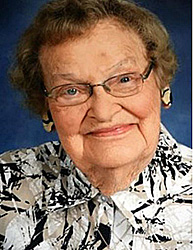
Clarence Michens and Bea Proffitt (shown at left in 2013), resident since the opening of the apartments, cut the ribbon between the columns. Inside, at the ample buffet tables, Bea and her sister, also a resident, spoke about attending Scottsville High School. "It was a close-knit school," said Frankie Turner. "I remember the apron which I made in Home Ec. and embroidered with my name, Francis." "We're from a large family," said Bea, "and we're a large family here. I'm living in the apartment that was the classroom where Mrs. Sutherland tried to teach me math." 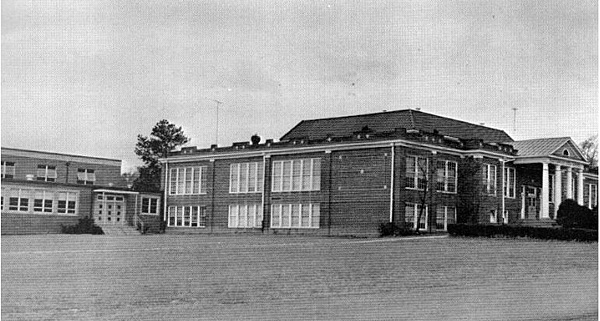 Scottsville High School, 1963 Copyright © 2020 by Scottsville Museum Top Image Located On: Capturing Our Heritage, CDB6 Roll5Neg24A.tif Roll5Neg24A.jpg Roll5Neg24A.psd Second Image Located On: Capturing Our Heritage, CDB5 Roll4Neg22A.tif Roll4Neg22A.jpg Roll4Neg22A.psd Third Image Located On: Courtesy of Scottsville Library Collection, Scottsville, VA. Fourth Image Located On: Capturing Our Heritage, CDB6 Roll5Neg20A.tif Roll5Neg20A.jpg Roll5Neg20A.psd Fifth Image Located On: Capturing Our Heritage, KM09; Photo courtesy of Kathleen McNamara. KM209bcdKM09.tif KM209bcdKM09.jpg KM209bcdKM09.psd Sixth Image Located On: Photo courtesy of Ruth Klippstein Seventh Image Located On: Thacker Brothers Funeral Home Website; https://www.thackerbrothers.com/obituary/Beatrice-Proffitt . Eighth Image Located On: 1963 Scotty, Vol. XVI, Scottsville High School, Scottsville, VA; available at Scottsville Museum Bottom Image Located On: Capturing Our Heritage, CDB17 B93cdB17.tif B93cdB17.jpg B93cdB17.psd |
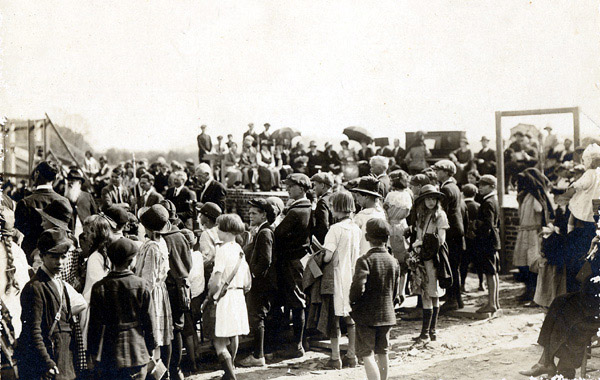
|
|
|
Museum
Archive
Business
Cemeteries
Church
Events
Floods
For Kids
Homes
Portraits
Postcards
School
Transportation
Civil War WWII Esmont Search Policy |
||||
|
Scottsville Museum · 290 Main Street · Scottsville, Virginia 24590 · 434-286-2247 www.avenue.org/smuseum · info@scottsvillemuseum.com Copyright © 2020 by Scottsville Museum |
||||